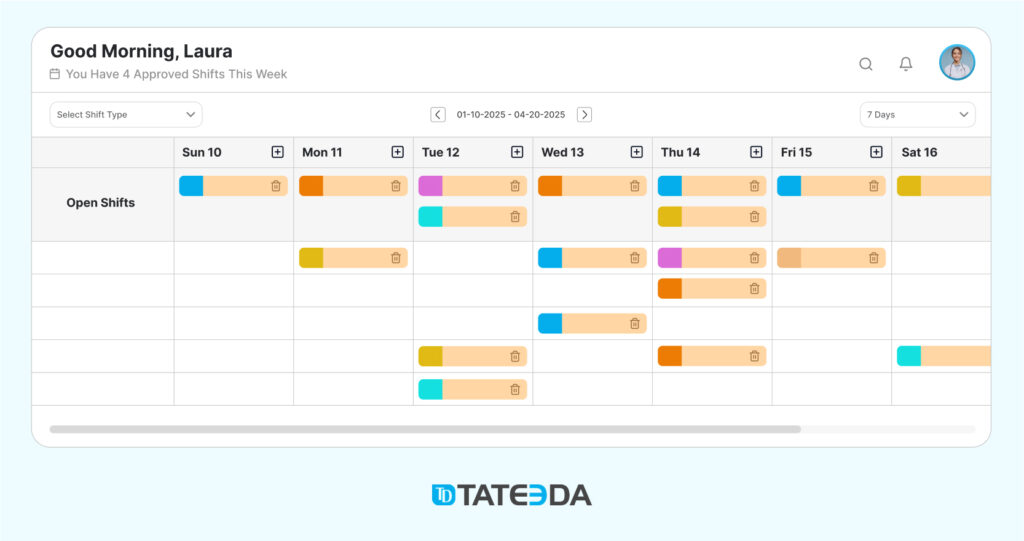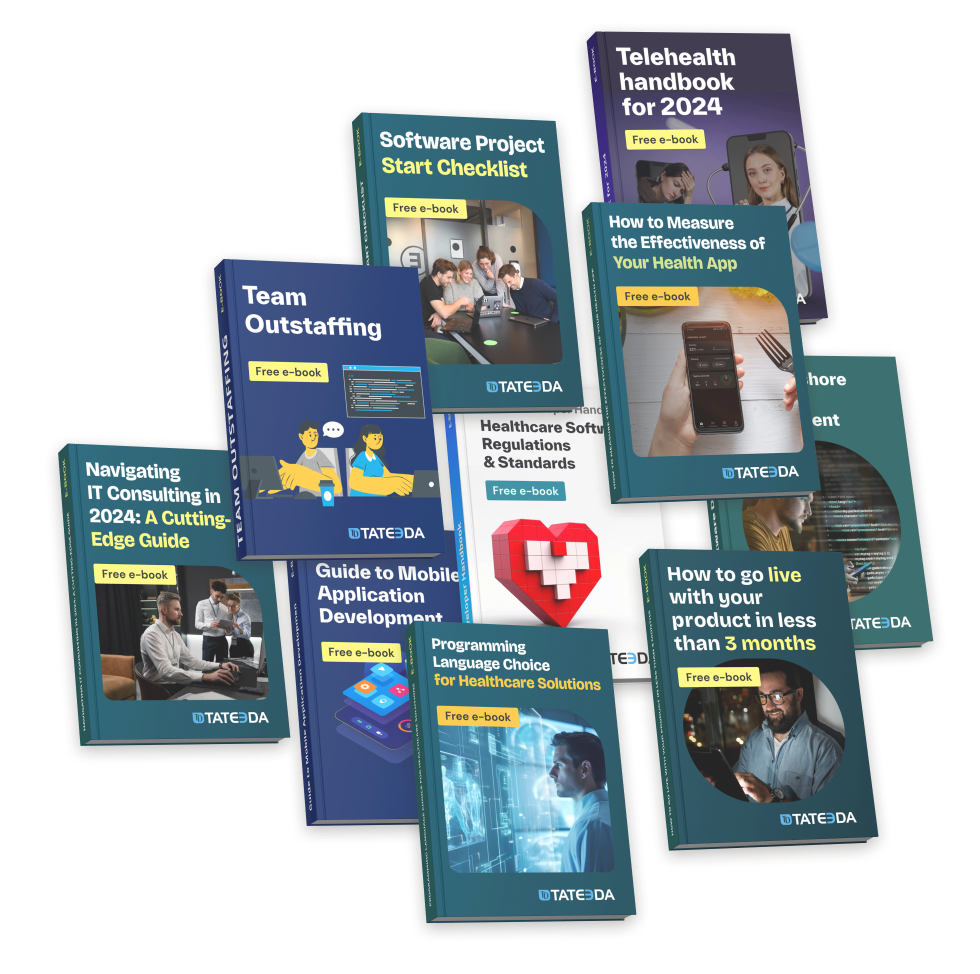The Top 11 Benefits of Cloud-Based Staffing Solutions for Healthcare: How to Improve Medical Staffing with Cloud Software

In this article, we’ll discuss how cloud integration in healthcare HR can simplify staff rota management, expedite RN and physician credentialing workflows, and enable elastic workforce scaling. You’ll discover how cloud-based healthcare staffing software supports these improvements and learn best practices for a seamless migration.
Ever wondered how much data your staffing system needs to hold?
Consider a mid-sized travel nurse agency or community hospital in the United States. These organizations often use their healthcare staffing software solutions to manage about 600 active clinicians on assignment at any given time. Each provider’s file can include multiple scanned licenses (about 1,500 total), training certificates, compliance records, and performance notes, which together add up to roughly 700 GB of live data plus backups.
Running that in-house could cost $30,000 in server hardware, $15,000 for database software, and another $80,000 a year for IT support and maintenance; these numbers make cloud-based healthcare staffing software solutions look downright irresistible…
When we partnered with Travel Nurse Healthcare, we built a custom cloud staffing software for hospitals that spans a multi-cloud and hybrid cloud environment across AWS, Microsoft Azure, and Google Cloud.
Our team set up containerized microservices, auto-scaling groups, load balancers, CI/CD pipelines, and API gateway orchestration to ensure seamless cloud integration in healthcare HR. This hands-on case study shows why we’re qualified to talk about healthcare staffing software solutions and how to architect reliable, secure systems at scale.
By shifting to a full healthcare software cloud migration, you replace costly capital outlay and a large IT team with a pay-as-you-go model: About $5,000 a month in cloud services versus over $100,000 in upfront and ongoing in-house expenses.
Cloud-based healthcare staffing software delivers elastic capacity, automatic failover, built-in disaster recovery, and continuous monitoring, all without long-term hardware commitments. The result is greater agility, tighter compliance, and more budget freed up for patient-focused initiatives.
Here’s what it looks like to have your HR solution developed, migrated, and running in the cloud:
| What It Means | Why It Matters |
| Hosted on cloud platforms like AWS, Microsoft Azure, Google Cloud, and IBM Cloud | Provides high availability, global reach, and enterprise-grade infrastructure without upfront hardware investments |
| Automatic resource scaling | Adapts compute and storage to match peak scheduling loads and idles down to control costs |
| Built-in disaster recovery across multiple regions | Ensures continuous access to your staffing data and rapid failover in case of an outage |
| Leverages cloud compliance frameworks for HIPAA and SOC 2 | Simplifies regulatory adherence and secures sensitive employee and patient information |
| Pay-as-you-go billing model | Optimizes budgets by charging only for the compute, storage, and network you consume |
| Enables cloud integration in healthcare HR via open APIs | Connects your cloud-based healthcare staffing software solutions to EHR, payroll, and credentialing systems without custom middleware |
| Real-time monitoring and analytics with cloud-native tools | Delivers actionable insights on performance, usage, and security, so you can respond before issues become problems |
Do You Need Help Moving Your HR Operations to the Cloud?
Our cloud engineers are standing by to assist. We’ve been building and migrating cloud software solutions since the early days of the technology.
Table of Contents
Staffing Pain Points vs. Advantages of Cloud Healthcare Staffing Systems
1. Predictive Workforce Analytics
🔍 The Challenge: Hospital or nurse agency staffing managers often scramble to fill shifts when census spikes or patient acuity climbs unexpectedly.
💡 Why Cloud Helps: Cloud-based healthcare staffing software centralizes historical schedules, admission rates, and census data in one secure repository. Machine-learning models running on elastic cloud servers spot patterns weeks ahead, so your healthcare staffing specialists avoid shift conflicts and last-minute difficulties.
⚙️ How It Works: Every night, your system ingests the day’s admission counts and open shift data, updating demand forecasts. Automated reports arrive in your inbox each morning, highlighting units likely to need extra support.

2. Dynamic EMR/EHR Access Provisioning
🔍 The Challenge: Granting or revoking EHR privileges manually leads to security gaps and orphaned accounts.
💡 Why Cloud Helps: With cloud integration in healthcare HR, your staffing software solution hooks into IAM (Identity and Access Management) services offered by AWS or Azure. Permissions update instantly when credential status changes, which helps to close/prevent security holes.
⚙️ How It Works: When a nurse’s license expires, an API call from your cloud staffing software for hospitals triggers deactivation in Epic or Cerner (thanks to API-based integration with Epic and Cerner EHR systems.) Restored credentials flow back automatically after renewal.
3. Self-Service Micro-Scheduling
🔍 The Challenge: Coordinators spend hours juggling shift swaps and approvals over email or paper forms.
💡 Why Cloud Helps: Cloud staffing solutions for healthcare enable mobile-friendly portals where staff propose swaps, pick up extra shifts, or release time slots. The cloud’s always-on availability means clinicians can adjust schedules from home or the break room.
⚙️ How It Works: A serverless function validates swap requests against skill requirements and staffing ratios, routing valid changes to managers for one-click approval.

4. Portable Credential Repository
🔍 The Challenge: Travel nurses and PRN staff waste days resubmitting the same documents at each facility.
💡 Why Cloud Helps: A centralized, encrypted cloud vault for digital credentials and automated healthcare staff credentialing, typical of medical staffing cloud software, lets you store verifications once and share them with any participating client or facility. No more faxed copies or lost paperwork.
⚙️ How It Works: After primary-source verifications (Nursys, CAQH, NPDB), credential files are uploaded to the cloud. A secure link is issued to each new assignment location, granting read-only access without downloads.
5. Immutable Compliance Audit Trails
🔍 The Challenge: Manual logs and spreadsheets can’t guarantee unaltered records for regulatory inspections.
💡 Why Cloud Helps: Many cloud healthcare staffing software solutions now write every credential check, contract change, and approval into append-only cloud storage that meets Joint Commission and CMS requirements.
⚙️ How It Works: Each action, like clicking “Approve License”, creates a time-stamped entry in a versioned database. When auditors arrive, you export a PDF report showing exactly who did what and when.
6. IoT-Driven Rounding Optimization
🔍 The Challenge: Manually balancing nurse assignments during peak hours leads to coverage gaps or assignment conflicts.
💡 Why Cloud Helps: By integrating occupancy sensors and wearable beacons into your cloud staffing software for hospitals, you feed live location data into your shift-management engine. Cloud computing scales to process streams from hundreds of devices at once.
⚙️ How It Works: As a sensor reports an empty room, the system flags it and recommends reassigning a nearby nurse, pushing it as a notification to the charge nurse’s tablet.
7. Disaster Response Orchestration
🔍 The Challenge: Natural disasters or system outages demand rapid, coordinated redeployment of staff across sites.
💡 Why Cloud Helps: One of the core benefits of cloud-based healthcare staffing software is its multi-region disaster recovery. When one data center goes offline, another takes over in seconds, keeping surge-pool management active.
⚙️ How It Works: A failover script in your cloud migration setup monitors health checks; if downtime occurs, the backup region’s app server spins up and alerts coordinators to activate contingency staffing plans.
8. Virtual Float Pools Across Regions
🔍 The Challenge: Smaller facilities struggle to share per-diem and travel clinicians without dozens of local contracts.
💡 Why Cloud Helps: With healthcare staffing software solutions in the cloud, you host a single roster that spans all locations. Clinicians log in to the same portal whether they’re in Boston or Boise.
⚙️ How It Works: A shared cloud database tracks availability, credentials, and prior assignments, then matches open shifts to qualified staff across your network.
9. Fatigue and Burnout Alerts
🔍 The Challenge: Excessive shifts and missed breaks contribute to errors and staff turnover.
💡 Why Cloud Helps: Cloud-based healthcare staffing software can ingest shift-pattern data and break logs, running fatigue-risk algorithms that trigger alerts when clinicians approach unsafe hours.
⚙️ How It Works: As soon as someone works 12 hours without a required break, the system sends a text message reminder and locks out overtime scheduling until compliance is restored.
10. Sustainability & Carbon Tracking
🔍 The Challenge: Healthcare’s carbon footprint grows with travel, energy-intensive equipment, and on-premise hardware.
💡 Why Cloud Helps: Moving to cloud integration in healthcare HR eliminates the need for data-center power and cooling on-site. Modern cloud providers report carbon offsets and efficiency metrics.
⚙️ How It Works: Your staffing solution logs every telehealth or remote shift as a carbon saving; a dashboard calculates reduced travel miles and estimates CO₂ avoided, ready for ESG reports.
11. Diversity & Skills-Gap Dashboards
🔍 The Challenge: Manual spreadsheets can’t reveal where representation or competencies fall short.
💡 Why Cloud Helps: Cloud-based healthcare staffing software aggregates demographic and clinical competency data in a single view. Role-based dashboards update continuously as new hires or certifications are added.
⚙️ How It Works: A predefined report flags units where diversity percentages or specialty credentials dip below target thresholds, helping HR teams launch targeted recruitment or training programs.
Not Sure Which Cloud Systems to Integrate with Your HR?
We’ll help you select and connect the right cloud platforms and products for seamless HR data exchanges and integrations.
Which Systems Should Your Cloud HR Software Connect With and Why?
Think about your daily routine with a fully integrated cloud HR platform versus scattered tools and spreadsheets. In this healthcare HR cloud software comparison, we’ll show how connecting to EHR, billing, credentialing, and scheduling systems can transform your operations.
With cloud-based staffing automation in healthcare powered by secure cloud platforms for medical staffing, you cut manual steps, boost data accuracy, and flex capacity on demand—proof that the scalability of cloud healthcare staffing software isn’t just marketing speak but a real way to improve healthcare staffing with cloud software. Read on to see these integrations in action:
| System | Integration & Benefits |
| Epic | Connects via Cerner Code APIs for seamless exchange of HR records, time-off requests, and credential statuses. Cloud integration in healthcare HR ensures audit-ready logs and instant role provisioning. |
| Cerner | Veradigm Developer Program APIs push credential, scheduling, and payroll updates into your cloud staffing software for hospitals. Built-in error checks maintain compliance and data integrity. |
| Athenahealth | Uses App Orchard APIs to sync clinician credentials, schedules, and payroll data into cloud-based healthcare staffing software. Real-time updates prevent orphaned accounts and speed shift assignments. |
| Allscripts | RCM and clinical decision support APIs feed time-tracking, payroll, and credential workflows into your cloud HR platform. This reduces payroll errors and aligns staff levels with patient demand. |
| eClinicalWorks | Healow APIs let you pull clinician availability and time logs directly into your cloud-based healthcare staffing software. Centralized data supports predictive staffing analytics and smoother coverage planning. |
| Meditech | Expanse APIs integrate HR data, such as licensure renewals and shift records, with your cloud staffing solutions for healthcare. Automatic alerts flag expiring credentials and prevent scheduling mishaps. |
| NextGen | Interoperability APIs connect vendor rosters and remote-worker time reports to cloud infrastructure. You gain a unified view of costs, billing, and attendance across multiple practice locations. |
| Greenway | Offers API Marketplace hooks to import employee profiles, billing rates, and performance notes into the medical staffing cloud software. Automated data feeds reduce manual entry and accelerate onboarding. |
| DrChrono | Developer APIs allow cloud HR software for small business teams to sync employee records and shift data with billing modules. Automated invoicing and labor cost reports live-update as hours are entered. |
| AdvancedMD | Combines EHR and billing APIs to feed clinician schedules and pay rates into your cloud deployment. The result is faster payroll runs and clear financial analytics—one of the top benefits of cloud-based healthcare staffing software. |
| Practice Fusion | RCM and EHR APIs stream employee profiles, credential statuses, and payroll data into a multi-tenant cloud HR platform. You benefit from scalable storage, built-in disaster recovery, and reduced IT overhead, which are the key advantages of cloud staffing solutions for healthcare. |
| CareCloud | RCM and EHR APIs stream employee profiles, credential statuses, and payroll data into a multi-tenant cloud HR platform. You benefit from scalable storage, built-in disaster recovery, and reduced IT overhead, which are the key advantages of cloud staffing solutions for healthcare. |
Case Study: Custom Cloud Deployment for a Leading Travel Nurse Agency
We partnered with one of the largest travel nurse agencies in the US (name withheld under NDA) to build a robust, cloud-based healthcare staffing software platform. Our goal was to automate core HR and financial workflows, streamline recruitment and credentialing, and deliver 24/7 accessibility for every stakeholder across the San Diego area and other locations: nurses, administrators, and hospital reps alike.

Our cloud healthcare staffing software solutions include:
- Financial module that calculates wages per assignment, bonuses, and multi-state tax withholdings
- Automated scheduling engine tied to live availability and skill requirements
- Workforce analytics dashboard for headcount planning and utilization rates
- Seamless compliance checks against licensure databases and exclusion lists
- Mobile and web apps showing up-to-date credentials, pay rates, hours worked,d and assignment details
- API-driven cloud integration in healthcare HR with EHR systems and billing platforms.
This end-to-end solution runs on a multi-cloud and hybrid cloud architecture using AWS, Azure, and private-cloud resources to balance loads, ensure continuous uptime, and orchestrate backups across regions.
The Final Word: How to Move Your HR Solution to the Cloud
If you’re ready to deploy cloud-based healthcare staffing software, we can help your nursing agency or healthcare organization design and launch an HR/staffing system that maximizes cost efficiency, enhances accessibility, and simplifies staff operations. Our services include:
- Cloud system architecture and multi-cloud or hybrid-cloud deployment
- Software integrations with EHR, billing, payroll, and credentialing platforms
- Custom AI assistant development services for medical staffing, such as automated balance of staff schedules and AI-driven matching of assignments based on each specialist’s individual availability, skills, and credentialing status
- Real-time workforce analytics, compliance monitoring, and mobile/web app enablement.
Contact us to learn how our cloud integration in healthcare HR and healthcare staffing software solutions can transform your operations.








